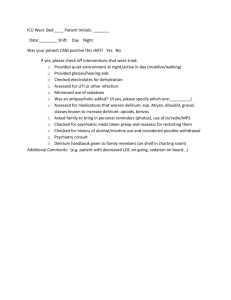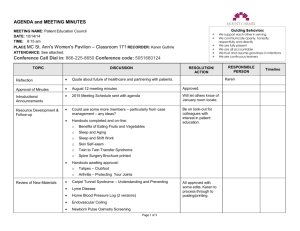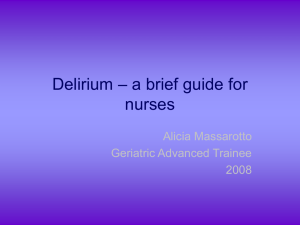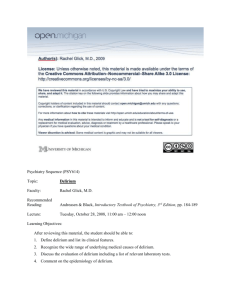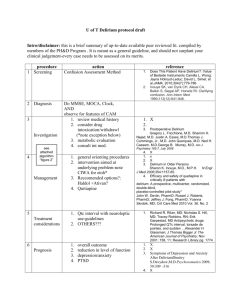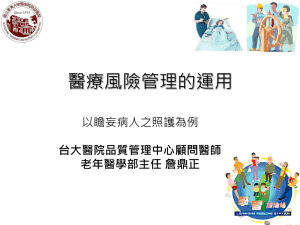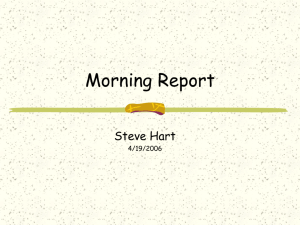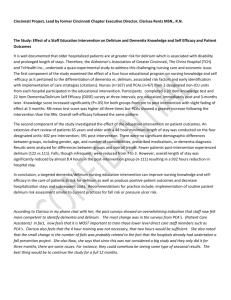Treat Causes
advertisement
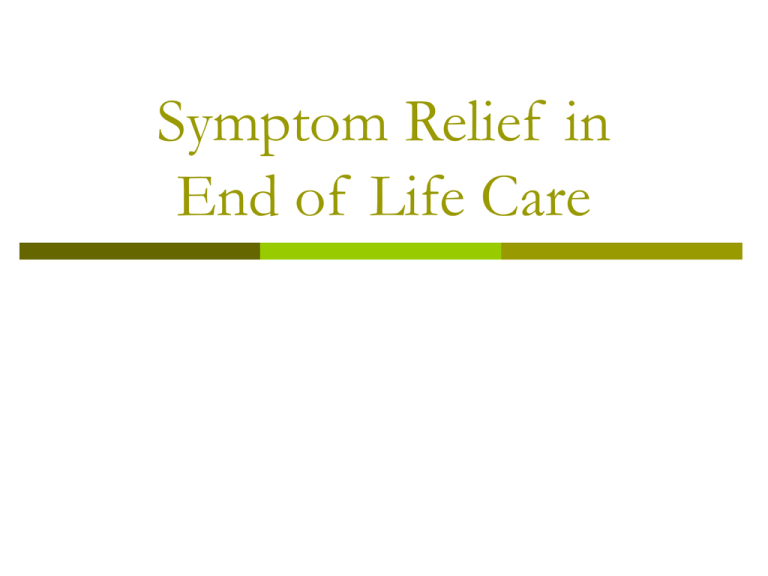
Symptom Relief in End of Life Care Goals, Objectives, Standards Apply a full set of skills in end of life care Bookmark websites with end of life care information for future ongoing use Discuss feeling regarding death and dying Dying: Common Family Concerns Is my loved one in pain; how would we know? Aren’t we just starving my loved one to death? What should we expect? How will we know that time is short? Should I/we stay by the bedside? Can my loved one hear what we are saying? What do we do after death? Dying: Timing < 1 day to 14 days Well nourished, hydrated, uninfected patients live longer Goal Setting and Communication Confirm treatment goals Stop Rx unrelated to comfort Progress notes “Patient is dying", not “Prognosis is poor". Treat symptoms/signs as they arise Provide daily counseling and support to family Communication Open, honest rapport Diversity Spirituality Dying: Early Bed Bound Loss of interest and/or ability to drink/eat Cognitive changes Increased sleep Delirium Dying: Mid Progressive decline in mental status Obtundation Terminal Delirium Death rattle Dying: Late Coma Fever Altered respiratory pattern Aspiration Pneumonia Dehydration Apnea Hypopnea Hyperpnea Irregularity Cheyne-Stokes Mottled extremities Livido Mortis vs Livido Reticularis Symptom Relief Pain Somatic Bone Neuropathic Dyspnea Secretions Myoclonus Seizures Singultus Pruritis Anxiety Insomnia Delirium and Terminal Delirium Spiritual Crisis and Distress Goal Setting and Communication Pain Narcotics are safe and effective Multiple products and routes Bowel regimens Adjunctive therapies Pain: Somatic WHO protocol Mild: Non-pharmacologic, Acetaminophen Moderate: NSAID, ASA Severe: Narcotics Fixed twice daily dosing Break-through medication Oral 3x parenteral Equivalency charts Treat anxiety, depression, psychiatric illness Bone Pain Bisphosphonates Prophylaxis Breast cancer and multiple myeloma most responsive Lung, GI and prostate carcinomas less responsive 50-70% of patients get 30% pain reduction by a week for 12 wk Repeat in a week for lack of response Zoledronic acid 4mg IV over 15 minutes, cheaper, faster Pamidronate 90mg IV administered over 2 hours, expensive, slower Decreases skeletal-related events by 30% if known bone involvement Toxicity Pamidronate and zoledronic acid identical. Injection site reaction, Flu-like syndrome Hypocalcemia, Scleritis less common Renal dysfunction in long-term, or high dose use Contraindicated CRF, Cr>0.5 over baseline or Cr>1.0 in CRI Reduced dose CrCl <73.0 mg/dl, and slower infusion Pain: Neuropathic Gabapentin Tricyclics Narcotics Dypnea Anxiolytics Moving Air Open doors and windows Mouth Care Secretions: Overview Death Rattle Turbulent air over pooled Median time from onset to death 16 hr Two sub-types of Death Rattle proposed significance regarding treatment not established Type 1 = predominantly salivary secretions Type 2 = predominantly bronchial secretions. Secretions: Non-pharmacologic Rx Postural drainage Position patient lateral or semi-prone A minute or two of Trendelenburg Gentle oropharyngeal suctioning aspiration risk is increased. often ineffective Frequent suctioning disturbs patient and visitors Reduce fluid intake Secretions: Pharmacologic Rx Drug Route Dose Onset Cross Notes BBB? hyoscyamine hydro. (Scopolamine Patch) Patch 1 or more patches (about 1mg/3d) 12 hr Yes hyoscyamine sulph. (Levsin) PO 0.125 po Q2-6 hr 30 min No Glycopyrrolate (Robinul) PO 1 mg/2-12 hr 30 min No SC, IV .2 mg 1 min Most potent Erratic absorption PO, SL 1-10 gtt 1% Q2-6 hr 1 mg 30 min Yes Cheap Flexible Most delirium Atropine IM, IV 1 min Need short term interim meds 1st 12 hr Myoclonus Focal or generalized sudden, brief, shock-like, involuntary Disrupts sleep, aggravates families DDX Metabolic abnormalities Medication Induced Opioid-induced usually generalized, may be provoked by a stimulus or voluntary movement. Dystonia Focal CNS Seizure disorders. Nocturnal Myoclonus Sleep related Treatment Underlying cause Opioid induced: change opioid Benodiazepine Midazolam infusion Dantrolene 50mg to 100mg daily Medications opioids, anticonvulsants tricyclics SSRI's contrast dye anesthetics penicillins cephalosporins imipenem quinolones cannabinoids ifosfamide Seizures Usual Care May require large doses of medication Hiccups (Singultus) Pharmacologic Pharmacological Anti-Psychotics: Chlorpromazine - the only FDA approved drug for hiccups. Haloperidol – 2.0-5.0 mg (IM/PO) loading then 1-4 mg po tid Anti-Convulsants: Phenytoin - reportedly effective in patients with a CNS etiology 25-50 mg po tid qid. IV 25-50 mg in 500-1000cc of NS over several hours 200 mg slow IV push followed by 300 mg po qd. Valproic Acid and Carbamazepine :maybe Miscellaneous: Baclofen - The only drug studied in a double blind randomized controlled study for treatment of hiccups; 5 mg po q8H did not eliminate hiccups but provided symptomatic relief in some patients. Metoclopramide - 10 mg po qid maybe for stomach distension Nifedipine - 10 mg bid with gradual increase up to 20 mg tid maybe Last ditch: amitriptyline, inhaled lidocaine, ketamine, edrophonium, amantidine. Hiccups (Singultus) Non-Pharmacologic Irritant Gargling with water Biting a lemon Swallowing sugar Vagal Produce a fright response Vagal stimulation Carotid massage Valsalva maneuver Interruption of phrenic nerve transmission by rubbing over the 5th cervical vertebrae Respiratory Sneezing Coughing Breath holding Hyperventilation Breath into a paper bag Other Acupuncture Diaphragmatic pacing Surgical ablation of reflex arc Pruritis: Non-Pharmacologic Treat Causes Moisturizer Dermatologic Metabolic Hem/Onc Drugs Infection Allergy Psychogenic. Xerosis Cooling agents Calamine Menthol in aqueous cream 0.5%-2% Pruritis: Pharmacologic EMLA Cream Antihistamines Steroids Inflammatory itching Topical Systemic for refractory cases Aveeno Cholestyramine Histamine mediated itching Doxepin may work in selected cases Cholestatic Other Ondansetron, Paroxetine Naloxone Anxiety Address underlying causes Treat dyspnea Treat sleep deprivation Narcotic euphoria overlaps anxiolysis Address spiritual issues Benzodiazepines Other Drug Treatment Insomnia Symptom Relief Treat Undiagnosed Sleep Disorders Sleep Hygiene Relaxation Techniques Sleep Restriction Cognitive Behavioral Therapy Stimulus Control Therapy There is no EBM on nightmares The usual drug therapies Delirium and Terminal Delirium Waxing and waning level of consciousness Non-pharmacologic Rx Reduce or increase sensory stimulation Relatives and friends stay with patient Frequent reorientation Familiar objects Haloperidol 0.5 to 2 mg po IV q 1 hour: EBM Hyperactive Hypoactive High-potency short-acting anti-psychotics=drug of choice Underused Benzodiazepines Second choice “Paradoxical” worsening of delirium Overused Delirium and Terminal Delirium Other neuroleptics Chlorpromazine Probably comparable to haloperidol Olanzapine is up and coming Sedation is desired Newer atypical antipsychotic May help EMB scant Perhaps with underlying dystonia or Parkinsons Spirituality Chaplain Diverse pastoral care Music therapy Communication Ethical Issues “Truth-Telling” Family Euthanasia Hospice Resource Allocation Diversity and Ethnic Issues Cultural Competency in questioning Awareness of beliefs Ritual Communication Staff education Hospice Use liberally EPERC Medical College of Wisconsin http://www.eperc.mcw.edu/ Fast Facts are available for downloading onto your PDA. Information and download available at www.infingo.com/mninfo.htm EPEC http://www.epec.net/EPEC/webpages/index.cfm The EPEC Project, Northwestern University's Feinberg School of Medicine 750 N Lake Shore Drive, Suite 601 Chicago, IL 60611 Tel. 312/503-3732, FAX: 312/503-5868 Email: info@epec.net The EPEC Project was supported from 1996-2003 with funding from The Robert Wood Johnson Foundation. Last modified 12/09/2005. Summary EMB for symptomatic relief at the end of life is accumulating Many distressing symptoms can be remitted Web-based resources for information are readily available Bibliography Fast Facts and Concepts #109. Death rattle and oral secretions. Bickel K and Arnold R. March 2004. End-of-Life Physician Education Resource Center www.eperc.mcw.edu. DeMonaco D and Arnold R. Fast Facts and Concepts #114. Myoclonus. May 2004. End-of-Life Physician Education Resource Center www.eperc.mcw.edu . Fast Facts and Concepts #104. Miller M and Arnold R. Insomnia: Non Pharmacological Treatments. January 2004. End-of-Life Physician Education Resource Center www.eperc.mcw.edu Malhotra, S and Arnold R. MD Fast Facts and Concepts #88 . Nightmares. April 2003. End-of-Life Physician Education Resource Center www.eperc.mcw.edu Fast Facts and Concepts #81 Hiccups. Farmer, C. January 2003. End-of-Life Physician Education Resource Center www.eperc.mcw.edu Fast Facts and Concepts #37 Gunten CF, Ferris F. Pruritis. August, 2005. 2nd edition. End-of-Life Palliative Education Resource Center www.eperc.mcw.edu Bibliography Diagnosis and Management of terminal delirium. Fast Fact and Concept #1; 2nd Edition, July 2005. End-of-Life Palliative Education Resource Center www.eperc.mcw.edu Syndrome of Imminent Death. Fast Fact and Concept #3; 2nd Edition, July 2005. End-of-Life Palliative Education Resource Center www.eperc.mcw.edu Fast Facts and Concepts #60 Pharmacologic Management of Delirium; update on newer agents. Earl Quijada, M.D. and J. Andrew Billings, M.D.. January, 2002. End- of-Life Physician Education Resource Center www.eperc.mcw.edu Weinstein E and Arnold A. Fast Facts and Concepts #113. Bisphosphonates for bone pain. April 2004. End-of-Life Physician Education Resource Center www.eperc.mcw.edu
